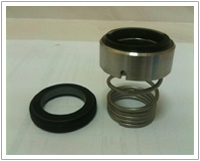How Long Will A Mechanical Seal Last ?
 Seal life is determined by a wide variety of factors, many of which are independent of the actual seal design. Installation issues, improper pump operation, and an not enough seal support system are just a few. During the selection of mechanical seal and its components very close attention must be needed to given including faces , o-rings and metallurgy to make sure its maximum life. Its also a very difficult to suitable select the seal type for each different application So that the installation procedure accurately followed The two most common seal care failure can occurs due to an heat generation and improper installation.Both of which has a multiple potential to causes root.
Seal life is determined by a wide variety of factors, many of which are independent of the actual seal design. Installation issues, improper pump operation, and an not enough seal support system are just a few. During the selection of mechanical seal and its components very close attention must be needed to given including faces , o-rings and metallurgy to make sure its maximum life. Its also a very difficult to suitable select the seal type for each different application So that the installation procedure accurately followed The two most common seal care failure can occurs due to an heat generation and improper installation.Both of which has a multiple potential to causes root.
Proper Installation Can Extend Mechanical seal life
Improper installation of mechanical seal can also is the major cause of failure. Installation can be performed by following the steps given by the manufacture and with great care to avoid the damage the of delicate seal faces/o-rings.If you forgetting to tighten the set screws before removing setting clips, not tightening gland bolts evenly, damaging O-rings, nicking seal faces, and piping connection errors are some of the common installation mistakes made when installing a seal.
Component seal installation is more vulnerable to installation error as compared to catridge seal due to an extra needed steps and measurements.Therefore mostly catridge seal design can be chosen over Component seal installation.There is always enough careful about when installing a mechanical seal; why add additional opportunity for installation mistakes?
By proper installation of mechanical seal by a trained a technician , by correct seal faces combination, a appropriate seal selection, a seal support piping line can extend the mechanical seal life.we know to follow these steps can be a costly .But if you not follow these steps you have to replace burned- out seal which is more costly than of this.
Prevent Decreasing Mechanical Seal Life from Heat Generation
Today’s most commonly used seal face combination is soft carbon seal. against harder silicon carbide face. This a Cool running seal combination if there is no seal support system, such as a flush plan, in place. Excess heat generation between seal faces will severely reduce seal life, and must be avoided. The softer carbon face against a silicon carbide face does not generate nearly as much heat as other face combinations, and is therefore a good option for seals without seal support systems.
Seal support systems, such as a plan 11 (flush line from pump discharge), a plan 13 (recirculation to pump suction), or a Plan 53A (pressurized barrier fluid with a seal reservoir), can be simple or highly complex, but they all have the same goal: to keep the seal faces clean, cool, and well-lubricated. If there is a seal support system and cuttings are present, changing the carbon face to either Silicon Carbide or a Tungsten Carbide face is a much better option for extending seal life, as the two hard silicon faces will be much more resistant to abrasion .









